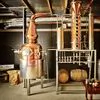Description
Distillation has a long and glorious history, in fact, it can be said to be paved with gold! There is evidence that the Babylonians had a rough understanding of the distillation process more than 3,000 years ago, and that they did not keep it a secret. By the 1st century BC, ancient civilizations in China, Pakistan, and Europe were being perfected, including the ancient Romans. Thanks to alchemy, the science of distillation was further developed. This discipline, somewhere between science and mysticism, is entirely concerned with turning materials into gold.
Advanced technology allowed later spirits to be distilled. The first book on distillation was published by the Germans in 1500, but the process was used to make perfumes or medicines. It was only 100 years later that attention began to be paid to the idea of drinking for pleasure. However, in the 19th century, modern forms of distillation were born!
Step 1: Get your device
The still works on a still and can be a tank distiller (the oldest type of still) or a column distiller. It was a complex machine with columns that stretched all the way to the ceiling. The still is connected to the condenser (the vessel through which the cooling water passes), and the condenser is connected to the barrel to collect the finished distillate.
Step 2: Clean the stills
Your still must be thoroughly cleaned before each distillation. After all, you don't want the dirt of the last distillation to mess with your gin!
Step 3: Add alcohol and botanicals
There are many unique distillation techniques that are often developed by distillers after months and years of experimentation. But the rationale remains the same: plant and alkaline alcohol (also known as "neutral alcohol") is first added to the distiller. This spirit is a fermented alcohol, usually made from grains, with no added spices. It is a mixture of water and pure alcohol.
Step 4: Heat up
Heat sources – some stills use an open flame, while others use a furnace or electric heat source – to start heating the bottom of the still. Alcohol begins to boil at 73 degrees Celsius, while water does not boil until 100 degrees Celsius. This means that the alcohol in neutral spirits will turn into gas and start to rise, while most of the water will remain at the bottom of the still.
Step 5: Cool down and capture
As a gas, the alcohol passes upwards through the distillation head, tank top or distillation column. It then passes through a condenser filled with cold water, where it cools and turns back into liquid. The final distillate drips into the bucket, where the still can decide whether to keep it or return to the still for a second round of distillation, becoming a higher concentration of water and alcohol solution.
Contact us
A wide range of models can meet the various requirements of each market and ensure that you can always find the right solution for you. If you would like to know more about our equipment, please contact us.
- Whiskey distillers
- brandy distillers
- gin distillers
- alcohol distillation equipment
- copper distillers
Production Capacity:
Not informed
Delivery Timeframe:
Within 45 Days
Incoterms:
CFR - Cost and Freight
CIF - Cost, Insurance and Freight
CIP - Carriage and Insurance Paid to
CPT - Carriage Paid to
DAF - Delivered At Frontier
DDP - Delivered Duty Paid
DDU - Delivered Duty Unpaid
DEQ - Delivered Ex Quay
DES - Delivered Ex Ship
EXW - Ex Works
FAS - Free Along Ship
FCA - Free Carrier
FOB - Free on Board
Packaging Details:
Not informed
More about
DEGONG equipment
10-50
Employees
500K - 1M
Sales volume (USD)
90%
% Export sales
Year
Established
Business type
- Industry / Manufacturer
Keywords
- beer brewing equipment
- alcohol distillation equipment
- filtration equipment
- tank valves and accessories
- mixing tanks
- packaging equipment
- chiller equipment
- food and beverage hoses
- etc. Ver Mais
Contact and location
-
Kate ********
-
+86 53********
-
Jinan City / Shandong Province | China






